“There’s a lot of ice around here!” — L. Peavey
We awoke this morning to the most spectacular views. Steep mountains covered in snow dipped into the water and large circles of ice (called “ice cake”) were everywhere.

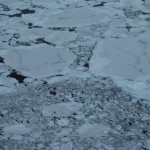
Since this is my first trip to Antarctica, I could barely wait to see outside. Danielle and I peeked out of our porthole before first light this morning and we were speechless. Well, speechless until we saw our first fur seal floating by and started jumping up and down and screaming. 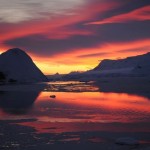 The sunrise filled the sky with glowing reds and yellows – unbeliev- able colors against the white of the snow.
The sunrise filled the sky with glowing reds and yellows – unbeliev- able colors against the white of the snow.
We saw a whole slew of creatures to kick off our trip. The morning started with some humpback whales, then killer whales (of course, they were spotted while the visual team was meeting down in the lab), a few more humpbacks, a minke whale, and plenty of fur seals. We saw a few crabeater seals resting with a fur seal on a bergy bit (also known as a small iceberg). Some lucky people even saw a leopard seal and a Weddell seal. Still, no penguins (although Ari claims to have seen a few). The picture below is of a fur seal that refused to move (and instead chose to hiss) as our ship passed it very closely.
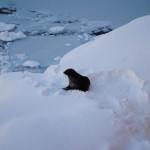
We spent the day in Wilhelmina Bay and calibrated a lot of our equipment. Before calibrating, we needed to find a spot that was free of ice. In the end, this involved clearing some ice with the ship, since about 70% of the bay was covered with ice. The prey mapping team spent the afternoon calibrating the 38 kHz and 120 kHz echosounders. This process involved using fishing rods on each side of the ship to suspend a copper ball and a tungsten carbide ball below the ship and pinging sound off of the balls. The returning signals are a known size, so the results from this calibration will allow us to interpret results for the rest of the cruise.
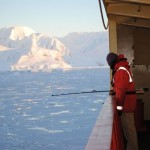
We also calibrated the radio-tracking equipment for the tags. One of the small boats took the tags out to test their range. Andrew was able to get a strong signal from over 2 km away, so he suspects that we’ll be able to detect the tags from 4 to 5 km away (if necessary) once they are on whales.
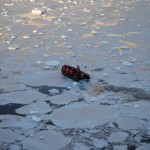
The visual observing team calibrated our eyes by estimating distances to various landmarks (most often icebergs) and then using a range finder to obtain the actual distance. It is amazing how small the Zodiac boat looks compared to the mountains, even when it is only 1050 meters (ummmm… 750 meters) away. We also climbed up to the conning tower, which will be one of our stations for visual observing. It’s approximately 80 feet above the water and the view is amazing! There is no way to describe how beautiful it is here!
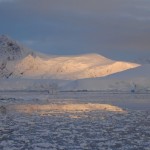
-Meagan

Hissing
You mean, you went all the way to Antarctic . . . only to have something else hiss at you? Beautiful scenery!
Wildlife
Awe! I am so excited for you guys! Sending warm wishes to you all.
Cakes!
We love cakes – even ice cakes! Awesome photos – thanks for sending them! Stay warm.
Antarctica
Lindsey, I am so excited for you~and bursting with pride too!! Safe journey!
Sunset
The way you described the sunset sounds so beautiful. I wish I could just see it in person. My teacher went to Antarctica, and the pictures she showed us were amazing. I want to go there someday.
Sounds Familiar
Seems like the world knows Meagon before she arrives, hiss on little Antarctica creatures!
That was a good story I enjoyed reading it. You need to go out on the Zodiac, i bet that is awesome being in a little boat in the middle of no where. Don’t be frightened. 🙂
Antarctic Wildlife and Pictures
These pictures look like the pictures that my Aquascience teacher, Ms. O’Neill had when she went to Antarctica. The pictures of the fur seal and the sunset look really amazing! These pictures and the article make me want to go to Antarctica.
Sunset
The picture of the sunset is so beautiful. It also looks similar to what Mrs. O’Neill, our aquascience teacher, showed us when she went to Antartica! I would love to there there someday!